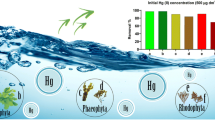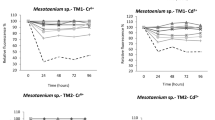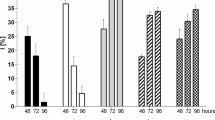Abstract
The research on metals effect on macroalgae has been focused on Cd, Cu, Zn and Pb, and no study dealt with the effects of mercury on macroalgae growth rate. Also, the kinetic of accumulation is not well known. The main aim of this work was to assess the mercury accumulation kinetics of Ulva lactuca and its effects on growth rate. Three concentrations were tested: 5, 50 and 500 μg L−1, under static and renewal conditions and at two salinities (15 and 35), during 72 h. The mercury accumulation kinetic patterns were different according to the exposure conditions and metal concentration, but were always a very fast process (hours). Three patterns were established based on the models substrate inhibition, linear regression and Michaelis–Menten equation. Statistical differences in the mercury accumulated were recorded depending on the salinity values and exposure conditions, being higher at salinity 15 and at renewal tests, corresponding to the lower relative growth rates. The lowest mercury concentration did not have an effect on relative growth rate, while the others caused an accentuated inhibition at 24 h. The highest concentration was toxic to algae causing its death before 48 h. Under controlled conditions, the U. lactuca’s high and fast ability for mercury accumulation could be useful for phytoremediation and for industrial wastewaters treatment.


Similar content being viewed by others
References
Andrade, S., Contreras, L., Moffett, J. W., & Correa, J. A. (2006). Kinetics of copper accumulation in Lessonia nigrescens (Phaeophyceae) under conditions of environmental oxidative stress. Aquatic Toxicology, 78, 398–401.
Amado Filho, G. M., Karez, C. S., Leonardo, R., Andrade, L. R., Yoneshigue-Valentin, Y., & Pfeiffer, W. C. (1997). Effects on growth and accumulation of zinc in six seaweed species. Ecotoxicology and Environmental Safety, 37(3), 223–228.
Baker, A. J. M. (1987). Metal tolerance. The New Phytologist, 106, 93–111.
Boening, D. W. (2000). Ecological effects, transport, and fate of mercury: A general review. Chemosphere, 40, 1335–1351.
Bold, H. C., & Wynne, M. J. (1978). Introduction to the algae: Structure and reproduction. New Jersey: Prentice Hall.
Coelho, J. P., Pereira, M. E., Duarte, A., & Pardal, M. A. (2005). Macroalgae response to a mercury contamination gradient in a temperate coastal lagoon (Ria de Aveiro, Portugal). Estuarine, Coastal and Shelf Science, 65(3), 492–500.
Coelho, J. P., Reis, A. T., Ventura, S., Pereira, M. E., Duarte, A. C., & Pardal, M. A. (2008). Pattern and pathways for mercury lifespan bioaccumulation in Carcinus maenas. Marine Pollution Bulletin, 56(6), 1104–1110.
Commission Regulation (EC) No. 466/2001. Official Journal of the European Communities. http://ec.europa.eu/food/fs/sfp/fcr/fcr02_en.pdf. Accessed 15 May 2010.
Crist, R. H., Martin, J. R., Carr, D., Watson, J. R., Clarke, H. J., & Carr, D. (1994). Interaction of metals and protons with algae. 4. Ion exchange vs adsorption models and a reassessment of scatchard plots; ion-exchange rates and equilibria compared with calcium alginate. Environmental Science & Technology, 28, 1859–1866.
Directive 82/176/EEC. Official Journal L81. 27.3.1982. p. 32.
Elumalai, M., Antunes, C., & Guilhermino, L. (2005). Alterations of reproductive parameters in the crab Carcinus maenas after exposure to metals. Water, Air, and Soil Pollution, 160(1), 245–258.
Fereshteh, G., Yassaman, B., Reza, A. M. M., & Hossein, M. (2007). Phytoremediation of arsenic by macroalga: Implication in natural contaminated water, Northeast Iran. Journal of Applied Sciences, 7(12), 1614–1619.
Fitter, A. H., & Hay, R. K. M. (2002). Environmental physiology of plants (3rd ed.). London: Academic.
Gerhardt, K. E., Huang, X. D., Glick, B. R., & Greenberg, B. M. (2009). Phytoremediation and rhizoremediation of organic soil contaminants: Potential and challenges. Plant Science, 176(1), 20–30.
Han, T., & Choi, G. W. (2005). A novel marine algal toxicity bioassay based on sporulation inhibition in the green macroalga Ulva pertusa (Chlorophyta). Aquatic Toxicology, 75, 202–212.
Han, T., Kang, S. H., Park, J. S., Lee, H. K., & Brown, M. T. (2008). Physiological responses of Ulva pertusa and U. armoricana to copper exposure. Aquatic Toxicology, 86, 176–184.
Hebel, D. K., Jones, M. B., & Depledge, M. H. (1997). Responses of crustaceans to contaminant exposure: A holistic approach. Estuarine, Coastal and Shelf Science, 44, 177–184.
Ho, Y. B. (1990). Ulva lactuca as bioindicator of metal contamination in intertidal waters in Hong Kong. Hydrobiologia, 203, 73–81.
Klaine, S. J., Lewis, M. A., & Knuteson, S. L. (2003). Phytotoxicity. In D. J. Hoffman, B. A. Rattner Jr., G. A. Burton Jr., & J. C. Cairns (Eds.), Handbook of ecotoxicology (2nd ed., pp. 191–218). Boca Raton: Lewis.
Laporte, J. M., Truchot, J. P., Ribeyre, F., & Boudou, A. (1997). Combined effects of water pH and salinity on the bioaccumulation of inorganic mercury and methylmercury in the shore crab Carcinus maenas. Marine Pollution Bulletin, 34(11), 880–893.
Lasat, M. M. (2002). Phytoextraction of toxic metals: A review of biological mechanisms. Journal of Environmental Quality, 31(1), 109–120.
Lee, W. Y., & Wang, W. X. (2001). Metal accumulation in the green macroalga Ulva fasciata: Effects of nitrate, ammonium and phosphate. The Science of the Total Environment, 27, 11–22.
Levitt, J. (1980). Responses of plant to environmental stresses. London: Academic.
Mackay, D. (1982). Correlation of bioconcentration factors. Environmental Science & Technology, 16, 274–278.
Masakorala, K., Turner, A., & Brown, M. T. (2008). Influence of synthetic surfactants on the uptake of Pd, Cd and Pb by the marine macroalga, Ulva lactuca. Environmental Pollution, 156(3), 897–904.
Medina, V. F., Maestri, E., Marmiroli, M., Dietz, A. C., & McCutcheon, S. C. (2003). Plant tolerances to contaminants. In J. L. S. Steven & C. McCutcheon (Eds.), Phytoremediation (pp. 189–232). New Jersey: Wiley-Interscience.
Miretzky, P., & Cirelli, A. F. (2009). Hg (II) removal from water by chitosan and chitosan derivatives: A review. Journal of Hazardous Materials, 167(1–3), 10–23.
Rainbow, P. S. (1995). Biomonitoring of heavy metal availability in the marine environment. Marine Pollution Bulletin, 31, 183–192.
Raskin, I., Smith, R. D., & Salt, D. E. (1997). Phytoremediation of metals: Using plants to remove pollutants from the environment. Current Opinion in Biotechnology, 8(2), 221–226.
Shiber, J., & Washburn, E. (1978). Lead, mercury and certain nutrient elements in Ulva lactuca from Ras Beirut, Lebanon. Hydrobiologia, 61, 187–192.
Stearns, J. C., Shah, S., & Glick, B. R. (2007). Increasing plant tolerance to metals in the environment. In W. Willey (Ed.), Phytoremediation: Methods and reviews (2nd ed., pp. 15–26). New Jersey: Humana.
Sunda, W. G., & Huntsman, S. A. (1988). Processes regulating cellular metal accumulation and physiological effects: Phytoplankton as model systems. The Science of the Total Environment, 219, 165–181.
Turner, A., Pedroso, S. S., & Brown, M. T. (2008). Influence of salinity and humic substances on the uptake of trace metals by the marine macroalga, Ulva lactuca: Experimental observations and modelling using WHAM. Marine Chemistry, 110, 176–184.
Válega, M., Lima, A. I. G., Figueira, E. M. A. P., Pereira, E., Pardal, M. A., & Duarte, A. C. (2009). Mercury intracellular partitioning and chelation in a salt marsh plant, Halimione portulacoides (L.) Aellen: Strategies underlying tolerance in environmental exposure. Chemosphere, 74, 530–536.
Vasconcelos, M. T. S. D., & Leal, M. F. C. (2001). Seasonal variability in the kinetics of Cu, Pb, Cd and Hg accumulation by macroalgae. Marine Chemistry, 74(1), 65–85.
Verslycke, T., Vangheluwe, M., Heijerick, D., De Schamphelaere, K., Sprang, P. V., & Janssen, C. R. (2003). The toxicity of metal mixtures to the estuarine mysid Neomysis integer (Crustacea: Mysidacea) under changing salinity. Aquatic Toxicology, 64, 307–315.
Vidotti, E. C., & Rollemberg, M. C. (2004). Algas: Da economia nos ambientes aquáticos à bioremediação e à química analítica. Quimica Nova, 27, 139–145.
Villares, R., Puente, X., & Carballeira, A. (2001). Ulva and Enteromorpha as indicators of heavy metal pollution. Hydrobiologia, 462, 221–232.
Walker, C. H., Hopkin, S. P., Sibly, R. M., & Peakall, D. B. (2004). Toxicity testing. In C. H. Walker, S. P. Hopkin, R. M. Sibly, & D. B. Peakall (Eds.), Principles of ecotoxicology (2nd ed., pp. 93–118). London: Taylor and Francis.
Wang, J., & Chen, C. (2009). Biosorbents for heavy metals removal and their future. Biotechnology Advances, 27(2), 195–226.
Wang, W. X., & Dei, R. C. H. (1999). Kinetic measurements of metal accumulation in two marine macroalgae. Marine Biology, 135(1), 11–23.
Water Framework Directive, 2000/60/EC. European Communities Official Journal L327 (22.12.2000).
Webster, E. A., & Gadd, G. M. (1996). Cadmium replaces calcium in the cell wall of Ulva lactuca. Biometals, 9, 241–244.
Yamashita, M., Tomita-Yokotani, K., Hashimoto, H., Sawaki, N., & Notoya, M. (2009). Sodium and potassium uptake of Ulva—Application of marine macro-algae for space agriculture. Advances in Space Research, 43, 1220–1223.
Acknowledgements
The present work was supported by FCT (Fundação para a Ciência e Tecnologia) through a PhD grant awarded to Sónia Costa (SFRH/BD/31247/2006). The authors are indebted to all colleagues that assisted in the field and laboratory work.
Author information
Authors and Affiliations
Corresponding author
Rights and permissions
About this article
Cite this article
Costa, S., Crespo, D., Henriques, B.M.G. et al. Kinetics of Mercury Accumulation and Its Effects on Ulva lactuca Growth Rate at Two Salinities and Exposure Conditions. Water Air Soil Pollut 217, 689–699 (2011). https://doi.org/10.1007/s11270-010-0620-9
Received:
Accepted:
Published:
Issue Date:
DOI: https://doi.org/10.1007/s11270-010-0620-9




